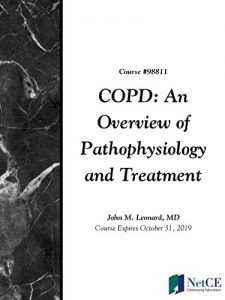The purpose of this course is to present healthcare professionals with the information needed to keep up to date on the best practice clinical guidelines for COPD and to refresh the importance of patient education. In addition, members of the public may use this course to enhance their personal knowledge of the subject matter presented.
Upon completion of this course, you should be able to:
1. Define chronic obstructive pulmonary disease (COPD) and associated conditions.
2. Identify risk factors and discuss the role of cigarette use, infection, and chronic inflammation in the pathogenesis and progression of COPD.
3. Correlate pathologic changes in the lung with the clinical features of COPD.
4. Describe the pathophysiology of airflow limitation and air trapping.
5. Recognize and evaluate the clinical signs and symptoms of COPD.
6. Analyze the various criteria and tests used in the diagnosis of COPD.
7. Discuss the investigations used to assess the severity and to stage COPD.
8. Identify interventions that may reduce the risk of developing COPD, including smoking cessation.
9. Outline pharmacologic and nonpharmacologic options for the management of stable COPD.
10. Use your knowledge of pathophysiology and options for therapy to devise a strategy for managing COPD exacerbations in the ambulatory setting or in the hospital.
11. Describe the appropriate monitoring and assessment of COPD disease progression, as well as associated comorbidities.
This 10-hour continuing education course is available for download for professional development; if continuing education credit is desired, please see instructions included in eBook.
Upon completion of this course, you should be able to:
1. Define chronic obstructive pulmonary disease (COPD) and associated conditions.
2. Identify risk factors and discuss the role of cigarette use, infection, and chronic inflammation in the pathogenesis and progression of COPD.
3. Correlate pathologic changes in the lung with the clinical features of COPD.
4. Describe the pathophysiology of airflow limitation and air trapping.
5. Recognize and evaluate the clinical signs and symptoms of COPD.
6. Analyze the various criteria and tests used in the diagnosis of COPD.
7. Discuss the investigations used to assess the severity and to stage COPD.
8. Identify interventions that may reduce the risk of developing COPD, including smoking cessation.
9. Outline pharmacologic and nonpharmacologic options for the management of stable COPD.
10. Use your knowledge of pathophysiology and options for therapy to devise a strategy for managing COPD exacerbations in the ambulatory setting or in the hospital.
11. Describe the appropriate monitoring and assessment of COPD disease progression, as well as associated comorbidities.
This 10-hour continuing education course is available for download for professional development; if continuing education credit is desired, please see instructions included in eBook.






